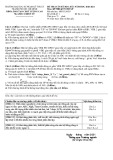System & Program System & Program Developments of 8051 Developments of 8051
(cid:147) Assembly Language Programming
(cid:147) Assembler Operation (cid:147) Assembly Language Program Format (cid:147) Assemble-Time Expression Evaluation (cid:147) Assembler Directives (cid:147) Assembler Controls (cid:147) Linker Operation (cid:147) Linking Relocatable Segments and Modules (cid:147) Macros
2011/12/7 T. L. Jong, Dept. of E.E., NTHU 1
System & Program System & Program Developments of 8051 Developments of 8051
(cid:147) Program Structure and Design
(cid:147) Introduction (cid:147) Advantages and Disadvantages of Structured
Programming
(cid:147) The Three Structures: statements, loops, choice (cid:147) Pseudo Code Syntax (cid:147) Assembly Language Programming
(cid:147) Tools & Techniques for Program Development
(cid:147) The Development Cycle (cid:147) Integration and Verification (cid:147) Command and Environments
2011/12/7 T. L. Jong, Dept. of E.E., NTHU 2
Assembly Language Programming
PROGRAM.OBJ
PROGRAM.SRC
ASM51
PROGRAM.LST
LIBRARY
PROGRAM.ABS
RL51
FILE1.OBJ FILE2.OBJ
PROGRAM.MAP
2011/12/7 T. L. Jong, Dept. of E.E., NTHU 3
/*assemble source program in input_file)*/ /*assemble source program in input_file)*/
ASM(input_file) ASM(input_file) BEGIN
/*lc=location counter; default to 0*/
/*pass 1: build the symbol table */ lc = 0; mnemonic = null; open input_file; WHILE (mnemonic != end) DO BEGIN
/*get line from input_file */ /*scan line & get label/symbol & mnemonic */
/*do nothing */
get_line(); scan_line(); IF (label) THEN enter_into_symbol_table(label, lc); CASE mnemonic OF BEGIN null, comment, END: ; ORG: EQU: DB:
lc = operand_value; enter_in_symbol_table( symbol, operand_value); WHILE (got_operand) DO increment_lc;
/* increment number of bytes defined */
lc = lc + operand_value;
DS: 1_byte_instruction: 2_byte_instruction: 3_byte_instruction:
lc = lc + 1; lc = lc + 2; lc = lc + 3;
END
2011/12/7 T. L. Jong, Dept. of E.E., NTHU 4
END
/*pass 2: create the object program*/ rewind_input_file_pointer; lc = 0; mnemonic = null; open_output_file; WHILE (mnemonic != end) DO BEGIN
get_line(); scan_line(); /* determine mnemonic op code and value(s) of operand(s)*/ /*Note: if symbols are used in operand field, their values are looked-up*/ */ /* in the symbol table created during pass 1 CASE mnemonic OF BEGIN
/*do nothing */
null, comment, EQU, END: ; ORG: lc = operand_value; DB: WHILE (operand) DO BEGIN put_in_objectfile(operand); lc = lc + 1;
END
/* increment number of bytes defined */
2011/12/7 T. L. Jong, Dept. of E.E., NTHU 5
lc = lc + operand;
DS: 1_byte_instruction: 2_byte_instruction:
3_byte_instruction:
put_in_objectfile(inst_code); put_in_objectfile(inst_code); put_in_objectfile(operand); put_in_objectfile(inst_code); put_in_objectfile(operand high-byte); put_in_objectfile(operand low-byte);
lc = lc + size_of_instruction;
END
END close_input_file; close_output_file;
END
2011/12/7 T. L. Jong, Dept. of E.E., NTHU 6
Assembly Language Program Format (cid:147) Assembly language program contains:
(cid:147) Machine instructions (ANL, MOV) (cid:147) Assembler directives (ORG,..) (cid:147) Assembler controls ($TITLE) (cid:147) Comments
(cid:147) Lines of machine instructions or
assembler directives: [label:] Mnemonic [operand] [,operand] […] [;comment]
2011/12/7 T. L. Jong, Dept. of E.E., NTHU 7
Assembly Language Program Format
(cid:147) Label & symbol
PAR
EQU 500
;PAR is a symbol ; which represents the ; value 500
START: MOV
A,#0FFH ;START is a label
;which represents the ;address of the MOV ;instruction
(cid:147) Special Assembler Symbols (cid:147) A, R0-R7, DPTR, PC, C, AB, $
2011/12/7 T. L. Jong, Dept. of E.E., NTHU 8
A,#1AH) A,#4) A,#9)
Assemble-Time Expression Evaluation (MOV A,#10 + 10H A,#25 MOD 7 (MOV A,#’9’ AND 0FH (MOV
(cid:147) MOV (cid:147) MOV (cid:147) MOV (cid:147) THREE
A,#(NOT THREE)+1 A,#Minus_three A,#11111101B
EQU 3 Minus_three EQU -3 MOV MOV MOV (cid:147) MOV (cid:147) MOV
A,#8 SHL 1 (MOV A,#HIGH 1234H (MOV
A,#10H) A,12H)
2011/12/7 T. L. Jong, Dept. of E.E., NTHU 9
Assemble-Time Expression Evaluation
(cid:147) Relational operators: result is always false
equal not equal less than less than or equal to greater than greater than or equal to
(0000H) or true (FFFFH) EQ NE LT LE GT GE MOV MOV MOV MOV MOV
= <> < <= > >= A,#5 = 5 A,#’X’ LT ‘Z’ A,#5 NE 4 A,#’X’ >= ‘X’ A,#$ > 0
2011/12/7 T. L. Jong, Dept. of E.E., NTHU 10
Assemble-Time Expression Evaluation
(cid:147) Expression Examples: 0001H ‘B’ - ‘A’ 8/3 0002H 155 MOD 2 0001H 0010H 4*4 0000H 8 AND 7 FFFEH NOT 1
‘A’ SHL 8 LOW 65535 (8 + 1)*2 5 EQ 4 ‘A’ LT ‘B’ 3 <= 3
4100H 00FFH 0012H 0000H FFFFH FFFFH
2011/12/7 T. L. Jong, Dept. of E.E., NTHU 11
Assemble-Time Expression Evaluation
(cid:147) Operator Precedence
( ) HIGH LOW * / MOD SHL SHR + - EQ NE LT LE GT GE = <> < <= > >= NOT AND OR XOR
(cid:147) When same precedence, operators are evaluated
left-to-right HIGH (‘A’ SHL 8) 0041H 0000H HIGH ‘A’ SHL 8 NOT ‘A’ - 1 FFBFH ‘A’ OR ‘A’ SHL 8 4141H
2011/12/7 T. L. Jong, Dept. of E.E., NTHU 12
Assembler Directives
(cid:147) Assembler state control (ORG, END, USING) (cid:147) Symbol definition (SEGMENT, EQU, SET,
DATA, IDATA, XDATA, BIT, CODE)
(cid:147) Storage initialization/reservation (DS, DB,
DW, DBIT)
(cid:147) Program linkage (PUBLIC, EXTRN, NAME) (cid:147) Segment selection (RSEG, CSEG, DSEG,
ISEG, BSEG, XSEG)
2011/12/7 T. L. Jong, Dept. of E.E., NTHU 13
Assembler State Controls
(cid:147) ORG, END, USING
ORG ORG
100H ($ + 1000H) AND 0F000H
;set to next ;4k boundary
END USING
;should be the last statement in the source file ;inform ASM51 of the currently expression ;active register bank
MOV
PSW,#00011000B
;select RB 3, the only way ;to switch register banks
;use register bank 3 ;1FH (R7 in bank 3)
USING PUSH MOV USING PUSH
3 AR7 PSW,#00001000B 1 AR7
;0FH
2011/12/7 T. L. Jong, Dept. of E.E., NTHU 14
Symbol Definition
(cid:147) The symbol definition directive creates
symbols representing segments, registers, numbers, & addresses.
2011/12/7 T. L. Jong, Dept. of E.E., NTHU 15
Symbol Definition
(cid:147) Segment (CODE, XDATA, DATA,IDATA,BIT)
symbol SEGMENT segment_type CODE (code segment) DATA (the internal data space accessible by direct
addressing 00-7FH)
IDATA (the entire internal data space accessible by indirect addressing, 00-7FH on 8051, 00-FFH on 8052)
XDATA (the external data space) BIT (the bit space; overlapping byte locations 20H-
2FH of the internal data space)
EPROM SEGMENT CODE (declares that EPROM is
a code segment. To actually begin using this segment, the RSEG directive is used)
2011/12/7 T. L. Jong, Dept. of E.E., NTHU 16
Symbol Definition
(cid:147) EQU and SET -- numbers
symbol EQU expression (assigns a numeric
value to a specific symbol name) EQU 27 EQU $
‘This is a message’
N27 HERE MESSAGE: DB LENGTH
EQU $-MESSAGE
symbol SET expression (similar to EQU except
that symbol can be redefined later using another SET directive)
2011/12/7 T. L. Jong, Dept. of E.E., NTHU 17
Symbol Definition
(cid:147) DATA, IDATA, XDATA, BIT, & CODE: assign addresses of the corresponding segment type to a symbol.
(cid:147) e.g.,
FLAG1 FLAG2
EQU BIT SETB SETB MOV MOV
05H 05H FLAG1 FLAG2 FLAG1,#0 FLAG2,#0
(error message: data segment address expected)
2011/12/7 T. L. Jong, Dept. of E.E., NTHU 18
Storage Initialization/Reservation
(cid:147) DS (define storage)
[label:]
DS
expression (reserves spaces in byte units,
can be used in any segment type except BIT)
DSEG AT 30H
;put in data segment ;(absolute , internal)
LENGTH EQU 40 BUFFER: DS
LENGTH
;reserve 40 bytes
LOOP:
MOV R7,#LENGTH MOV R0,#BUFFER ;R0=30H MOV @R0,#0 R0 INC DJNZ R7,LOOP
2011/12/7 T. L. Jong, Dept. of E.E., NTHU 19
Storage Initialization/Reservation (cid:147) Create 1000 bytes in external RAM at 4000H
EQU 4000H
XSTART XLENGTH EQU 1000
XSEG AT XSTART
XBUFFER: DS
;put I data segment ;(absolute , internal) ;reserve 40 bytes
LOOP:
XLENGTH MOV DPTR,#XBUFFER A CLR MOV @DPTR,A DPTR INC MOV A,DPL CJNE A,#LOW(XBUFFER + XLENGTH + 1),LOOP MOV A,DPH CJNE A,#HIGH(XBUFFER + XLENGTH + 1),LOOP (continue)
2011/12/7 T. L. Jong, Dept. of E.E., NTHU 20
Storage Initialization/Reservation
(cid:147) DBIT: reserve space in bit units
expression
[label:]
DBIT BSEG KBFLAG: DBIT PRFLAG: DBIT DKFLAG: DBIT
1 1 1
;bit segment, absolute (00H-7FH) ;keyboard status ;printer status ;disk status
(cid:147) DB (define byte): initialize code memory w bye values
[label:]
expression [,expression] […]
DB CSEG AT
0100H
;squares of number 0-5 ;null-terminated char string
0,1,4,9,16,25 ‘Login:’,0
SQUARES: DB MESSAGE:DB (cid:147) DW (define word)
[label:]
expression [,expression] […]
0200H
DW CSEG AT DW
$,’A’,1234H,2,’BC’
;02 00 00 41 12 34 00 ;02 42 43
2011/12/7 T. L. Jong, Dept. of E.E., NTHU 21
Program Linkage
(cid:147) Allows separately assembled modules (files) to communicate by permitting intermodule referencing and naming of the modules
(cid:147) PUBLIC (declare public for other modules to reference)
PUBLIC
symbol [,symbol] […]
allows the list of specified symbols to be known and used
outside the currently assembled module.
(cid:147) EXTRN (declare symbols defined outside current module)
EXTRN
symbol [,symbol] […]
MAIN.SRC
MESSAGE.SRC
CODE(HELLO,GOOD_BYE)
PUBLIC HELLO,GOOD_BYE
…
HELLO
HELLO: (begin sub)
GOOD_BYE
... RET
GOOD_BYE: (begin sub)
EXTRN … CALL … CALL … END
… RET
2011/12/7 T. L. Jong, Dept. of E.E., NTHU 22
Segment Selection
(cid:147) RSEG (selecting relocatable segment) RSEG segment_name
segment_name is previously defined by SEGMENT
directive.
(cid:147) Selecting Absolute Segments CSEG [AT address] DSEG [AT address] ISEG [AT address] BSEG [AT address] XSEG [AT address]
(cid:147) Each segment has its own location counter which is set to 0 initially
2011/12/7 T. L. Jong, Dept. of E.E., NTHU 23
Segment Selection
LOC
OBJ
SOURCE
ONCHIP SEGMENT EPROM SEGMENT
DATA CODE
BSEG AT 70H ;begin abs bit seg
---- 0070 0071
FLAG1: DBIT FLAG2 DBIT
1 1
RSEG ONCHIP ;begin relocatable data seg
---- 0000 0001 0002
TOTAL: DS COUNT: DS SUM16: DS
1 1 2
LINE 1 2 3 4 5 6 7 8 9 10 11 12 13
---- 0000 750000 F
14
RSEG EPROM ;begin relocatable code seg BEGIN: MOV TOTAL,#0 (continue program) END
15 16
2011/12/7 T. L. Jong, Dept. of E.E., NTHU 24
Assembler Controls
(cid:147) Establish the format of the listing and
object files. Controls the look of listing file, without having any effect on the program.
(cid:147) Can be entered on the invocation line or placed in the source program (preceded with $)
(cid:147) Primary controls and general controls (cid:147) e.g., DATE, INCLUDE, LIST, MACRO(50),
XREF
2011/12/7 T. L. Jong, Dept. of E.E., NTHU 25
Assembler Controls
NAME
DEFAULT
Meaning
Primary/ General
Abbrev .
DATE(date)
DATA()
DA
P
Places string in header (9 Char. max.)
DEBUG
NODEBUG
DB
P
Outputs debug symbol information to object file
NODEBUG
NODEBUG
NODB Symbol information not placed in
P
object file
Continue listing on next page
EJECT
Not applicable
EJ
G
ERRORPRINT
NOERRORPRINT
EP
P
Designates a file to receive error Messages in addition to the listing file (defaults to console)
NOERRORPRINT
P
NOERRORPRINT NOEP Designates that error messages will be printed in listing file only
GEN
GENONLY
GO
P
List only the fully expanded source as if all lines generated by a macro call were already in the source file
2011/12/7 T. L. Jong, Dept. of E.E., NTHU 26
Assembler Controls
GENONLY
G GENONLY
NOGE
List only the original source text in the listing file
INCLUDE(file)
G Not applicable
IC
Designates a file to be included as part of the program
LIST
G NOLIST
LI
Print subsequent lines of source code in listing file
NOLIST
G NOLIST
NOLI
Do not print subsequent lines of source code in listing file
P MACRO(50)
MR
MACRO(mem_percent )
Evaluate and expand all macro calls. Allocate percentage of free memory for macro processing
NOMACRO
P MACRO(50)
NOMR Do not evaluate macro calls
MOD51
P MOD51
MO
Recognize the 8051-specific predefined special function registers
NOMOD51
P MOD51
NOMO Do not recognize 8051-
specific predefined special function registers
2011/12/7 T. L. Jong, Dept. of E.E., NTHU 27
Assembler Controls
OBJECT(file)
P OBJECT(source.O
OJ
Designates file to receive object code
BJ)
NOOBJECT
P OBJECT(source.O
NOOJ
Designates that no object file will be created
BJ)
PAGING
P PAGING
PI
Designates that listing file be broken into pages and each will have a header
NOPAGING
P PAGING
NOPI
Designates that listing file will contain no page breaks
PAGELENGTH
P PAGELENGTH(60)
PL
Sets maximum number of lines in each page of listing file (range = 10 to 65,536)
PAGEWIDTH
P PAGEWIDTH(120)
PW
Sets maximum number of characters in each line of listing file (range = 72 to 132)
PRINT(file)
P PRINT(source.LST) PR
Designates file to receive source listing
NOPRINT
P PRINT(source.LST) NOPR
Designates that no listing file will be created
2011/12/7 T. L. Jong, Dept. of E.E., NTHU 28
Assembler Controls
SAVE
G Not applicable
SA
Stores current control settings from SAVE stack
RESTORE
G Not applicable
RS
Restores control settings from SAVE stack
REGISTERBANK(rb,..) P REGISTERBANK(0) RB
Indicates one or more banks used in program module
NOREGISTERBANK
P REGISTERBANK(0) NORB
Indicates that no register banks are used
SYMBOLS
P SYMBOLS
SB
Creates a formatted table of all symbols used in program
NOSYMBOLS
P SYMBOLS
NOSB
Designates that no symbol table is created
TITLE(string)
G TITLE()
TT
Places a string in all subsequent page headers (max. 60 characters)
WORKFILES(path)
P Same as source
WF
Designates alternate path for temporary workfiles
2011/12/7 T. L. Jong, Dept. of E.E., NTHU 29
Assembler Controls
XREF
P NOXREF
XR
Creates a cross reference listing of all symbols used in program
NOXREF
P NOXREF
NOXR
Designates that no cross reference list is created
2011/12/7 T. L. Jong, Dept. of E.E., NTHU 30
Linker Operations (cid:147) Intel RL51: links modules into an output
file: RL51 input_list [TO output_file] [location_controls] input_list: a list of relocatable object modules (files) separated by commas. Output_file: the name of the output absolute object module (executable program). Location controls: set start addresses for the named segments.
(cid:147) e.g., RL51 MAIN.OBJ,MESSAGE.OBJ, SUBROUTINE.OBJ TO EXAMPLE & CODE (EPROM(4000H)) DATA(ONCHIP(30H))
2011/12/7 T. L. Jong, Dept. of E.E., NTHU 31
Linker Operations
2011/12/7 T. L. Jong, Dept. of E.E., NTHU 32
Annotated Example: ECHO.LST
2011/12/7 T. L. Jong, Dept. of E.E., NTHU 33
Annotated Example: ECHO.LST
2011/12/7 T. L. Jong, Dept. of E.E., NTHU 34
Annotated Example: IO.LST
2011/12/7 T. L. Jong, Dept. of E.E., NTHU 35
Annotated Example
2011/12/7 T. L. Jong, Dept. of E.E., NTHU 36
Annotated Example
2011/12/7 T. L. Jong, Dept. of E.E., NTHU 37
Annotated Example
2011/12/7 T. L. Jong, Dept. of E.E., NTHU 38
Annotated Example: ECHO+IO
2011/12/7 T. L. Jong, Dept. of E.E., NTHU 39
2011/12/7 T. L. Jong, Dept. of E.E., NTHU 40
MACROS (cid:147) Macro allows frequently used sections of code to be defined once using a simple mnemonic and used anywhere in the program by inserting the mnemonic.
(cid:147) ASM51’s MPL: string replacement. (cid:147) %DEFINE (call_pattern) (macro_body) (cid:147) %DEFINE (PUSH_DPTR)
(PUSH DPH PUSH DPL)
(cid:147) %PUSH_DPTR will be replaced by PUSH DPH and PUSH DPL two instructions in the .LST file
2011/12/7 T. L. Jong, Dept. of E.E., NTHU 41
Advantages of Using Macros
(cid:147) More readable (cid:147) The source program is shorter and
requires less typing
(cid:147) Using macros reduces bugs (cid:147) Using macros frees the programmer from dealing with low-level details
2011/12/7 T. L. Jong, Dept. of E.E., NTHU 42
Parameter Passing
(cid:147) %DEFINE
(macro_name(parameter_list))
(macro_body)
(cid:147) %DEFINE (CMPA# (VALUE))
(CJNE A,#%VALUE, $ + 3 )
(cid:147) %CMPA# (20H) = CJNE A,#20H,$+3
2011/12/7 T. L. Jong, Dept. of E.E., NTHU 43
Parameter Passing
(cid:147) JUMP if A is greater than X: (cid:147) %DEFINE (macro_name(parameter_list)) (macro_body)
(cid:147) %DEFINE (JGT(VALUE,LABEL))
%LABEL
;JGT
(CJNE A,#%VALUE+1, $ + 3 ; JNC )
(cid:147) %JGT(‘Z’,GREATER_THAN)
2011/12/7 T. L. Jong, Dept. of E.E., NTHU 44
Local Labels (cid:147) %DEFINE (macro_name [(parameter_list)])
[LOCAL list_of_local_labels] (macro_body)
(cid:147) %DEFINE (DEC_DPTR) LOCAL SKIP
(DEC DPL
MOV A,DPL CJNE A,#0FFH,%SKIP DEC DPH
%SKIP: )
2011/12/7 T. L. Jong, Dept. of E.E., NTHU 45
Local Labels
(cid:147) %DEC_DPTR =
(cid:147)
DEC DPL MOV A,DPL CJNE A,#0FFH, SKIP00 DEC DPH
SKIP00:
(cid:147) Side effect: A is used and changed
2011/12/7 T. L. Jong, Dept. of E.E., NTHU 46
Preserve A by Push-Pop
(cid:147) %DEFINE (DEC_DPTR) LOCAL SKIP
(PUSH A DEC DPL MOV A,DPL CJNE A,#0FFH,%SKIP DEC DPH
%SKIP: POP A )
2011/12/7 T. L. Jong, Dept. of E.E., NTHU 47
Repeat Operations-- Built-in Macros
(cid:147) %REPEAT (expression) (text) (cid:147) %REPEAT (100)
(NOP )
2011/12/7 T. L. Jong, Dept. of E.E., NTHU 48
Control Flow Operations
(cid:147) Conditional Assembly in ASM51: (cid:147) %IF (expression) THEN (balanced_text)
[ELSE (balanced_text)]
INTERNAL
EQU 1 .
;1=8051 serial I/O drivers ;0=8251 serial I/O drivers
%IF (INTERNAL) THEN
;8051 driver
(INCHAR:
OUTCHR:
. . . .
) ELSE
(INCHAR:
;8251 driver
OUTCHR:
. . . .
)
2011/12/7 T. L. Jong, Dept. of E.E., NTHU 49














































